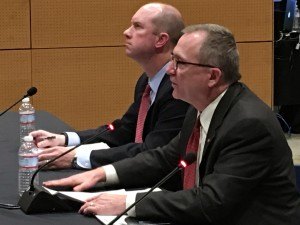UA System Board advances $160 million stadium redo, but Pryor has questions
by January 27, 2016 8:07 pm 286 views

The University of Arkansas System Board of Trustees voted to let the University of Arkansas Athletic Department take the next step on a $160 million renovation to the Donald W. Reynolds Razorback Stadium Wednesday, but not before former U.S. Sen. David Pryor, a board member, questioned the project’s costs and benefits and abstained from the vote.
The board was asked to approve the department seeking a full design and to begin marketing the idea in search of binding financial commitments from donors. UA officials pushed details of the renovation out Monday.
UA Athletic Director Jeff Long estimated the cost at $160 million, though that could change once the project is fully designed. It would be funded by a $120 million bond issue that will be brought to the board later, along with $40 million in capital donations. Increased ticket revenue would help pay back the bond issue. No university funds would be required to complete the project.
The renovation would include additions in the north end zone that would connect the east and west sides. About 3,200 premium seats would be added, as would a new game day locker room, training room, and pre/post game support rooms for the football team. New elevators would be installed at the northeast and northwest corners. Existing suites and club areas will be renovated and updated. A new video board would be added at the south end of the stadium.
The Frank Broyles Athletic Center administration area, designed when the UA had separate men’s and women’s athletic departments, would be rebuilt in the new north end. Leading to the stadium would be a new “Hog Walk” where the players would walk to the game as fans cheer them on – a process that now happens through the parking lot. Long said the addition would make it easier to get fans out of the stadium in a security situation.

“Our goal is not to provide the largest stadium,” he said. “We can’t support the largest stadium in the SEC. However, we want to give our fans a unique stadium – one that fits the state of Arkansas, one that’s as unique as the Razorback itself.”
Long said the financial model is based on six home games being played in Fayetteville each year. The UA has three years remaining on its contract to play one game each year in War Memorial Stadium in Little Rock. Changing that is “not something we’re even looking at at this point,” Long told reporters after the meeting. Long said also told reporters he hopes the project is finished in time for the 2018 season, with some aspects open in 2017.
Pryor praised Long and said he hoped to be able to support the project. However, he said he needed to first understand its costs and benefits – and who would pay the costs, and who would be able to take advantage of the benefits. He asked if students would gain from the project and if they would have to help pay off the debt. He pointed out that, earlier in the day, the board had heard needs expressed by other UA entities, including UAMS and UAPB. Pryor called the potential request “the largest single bond issue in the history of higher education in the state of Arkansas.”
“A bond issue is a debt of the University of Arkansas,” he said. “It is a debt of the people of Arkansas, and ultimately if something goes wrong, who’s responsible? And that’s the people.”
Long and Chief Financial Officer Clayton Hamilton told reporters that the department has less than $65 million in debt and will have no debt in 13 years.
“If you look around the country at athletic programs, you’ll find some with over $300 million of debt on their books,” he said. “We’re very conservative in that regard.”
The last major stadium renovation was completed in time for the 2001 season, according to the UA. In 2009, the UA hired consultants to develop a facilities master plan. Included was a general concept and program for the expansion of the stadium at the north end.
